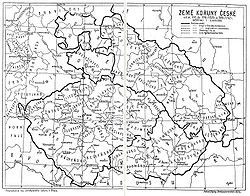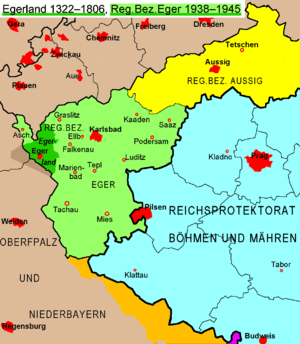- Egerland
-
The Egerland (Czech: Chebsko; German: Egerland; Egerland German dialect: Eghalånd) is a historical region in the far north west of Bohemia in the Czech Republic at the border with Germany. It is named after the German name Eger for the city of Cheb and the main river Ohře. Recently the northern parts around the town of Aš are also called Böhmisches Vogtland (Fojtsko) related to the adjacent German Vogtland region in Saxony, Thuringia and Bavaria, today constituent parts of the Egrensis Euroregion initiative.
Contents
Geography
The Egerland forms the northwestern edge of the Czech Republic. Originally, it was a small region of less than 1,000 km2 (390 sq mi) around the historic city of Cheb, roughly corresponding with the present-day Cheb District of the Karlovy Vary Region, originally with the exception of Aš, but including the headwaters of the Ohře river and the area of Marktredwitz in today's Upper Franconia.
In contrast, after the beginning of the German occupation of Czechoslovakia in 1938, Cheb and the historic Egerland were incorporated as part of the "Sudetenland" into an extended area of 7,466 km2 (2,883 sq mi). Though the seat of the administration was established at Karlovy Vary (Carlsbad) the entity was officially named Regierungsbezirk Eger in order to deduce territorial claims. It included large Bohemian territories up to the outskirts of Plzeň, comprising cities like Falknov (today Sokolov), Kraslice, Chodov, Mariánské Lázně (Marienbad), Tachov and Domažlice, which never belonged to historical region.
History
See also: ChebThe settlement of Eger in the Bavaria Slavica was first mentioned in 1061 records of trade routes laid out in the course of the German Ostsiedlung migration. In 1135 the regio Egere is recorded as a part of the Bavarian March of the Nordgau under the rule of Count Diepold III of Vohburg. After his death in 1146, the Egerland was inherited by the later Emperor Frederick I Barbarossa of Hohenstaufen by marriage with Diepold's daughter Adelheid. The Staufer finally severed the Provincia Egrensis from Bavaria and built it up as an exemplary model of a Reichsgut territory under immediate rule of the Holy Roman Emperor. Along this development Cheb became the site of a Kaiserpfalz residence (Chebský hrad), the only one in the present-day Czech Republic.
Kingdom of Bohemia
Cheb, a free imperial city since 1277, and the reichsunmittelbar Egerland were given as a lien to King John of Bohemia in 1322 by Emperor Louis IV of Wittelsbach. In return for John's support against Louis' rival Frederick of Habsburg at the Battle of Mühldorf, he received Eger as a Reichspfandschaft (Imperial lien) with the "guarantee of complete independence from the Kingdom of Bohemia". This reservation however became meaningless as Louis never redeemed the pawn, and with the accession of Emperor Charles IV of Luxembourg in 1346, the crowns of the Holy Roman Empire and Bohemia were united in one hand. Charles' successors from the House of Luxembourg and (from 1526) Habsburg continuously eliminated the autonomy of the Egerland against the resistance of the Cheb citizens and the local nobility. While the present-day Franconian parts up to the Fichtelgebirge were acquired by the Principality of Bayreuth under Hohenzollern rule, the remaining territory was administrated within the Bohemian kraj of Loket from 1751.
 Egerland (Chebsko) as one of the lands of the Bohemian crown.
Egerland (Chebsko) as one of the lands of the Bohemian crown.
The incorporation of the Bohemian kingdom into the Habsburg Monarchy had created ongoing conflicts at first along the fault-lines between the Catholic dynasty and the Protestant nobility culminating in the Thirty Years' War. Cheb and the Egerland insisting on their independence tried to maintain a neutral position, they nevertheless were seized as a stronghold by Albrecht von Wallenstein, who was murdered at Cheb on 25 February 1634. In the following decades the absolute Habsburg rulers aimed at a centralized government. Emperor Joseph II of Habsburg on the one hand issued an Edict of Religious Tolerance in 1781, but also denied the Bohemian autonomy by renouncing the ceremony of the coronation as Bohemian king. With the determination of German as official language in all Habsburg lands (instead of Latin), he laid the foundations for future ethnic conflicts. In the course of the dissolution of the Holy Roman Empire in 1806 and the onset of the Austrian Empire, the eastern part of Egerland finally became an ordinary district of the Austrian province of Bohemia.
The suppression during the Age of Metternich led to a second-class status of the Czech people in the Austrian crown land of Bohemia, despite them being much more numerous than the German speaking population. From about 1830 on Czech scholars like František Palacký encouraged the Austroslavism movement demanding autonomy for the Bohemian crown lands and admission of the Czech language. In the aftermath of the 1848 Spring of Nations, the Czechs, as well as some other Slavic nations, began Pan-Slavic movements aiming at complete independence, fiercely opposed by Pan-German organisations like the German Worker's Party based in Cheb. The rise of ethnic nationalism turned out to be fatal, as, while the central parts of Bohemia were only inhabited by a smaller German-speaking elite, in border regions like the Egerland people who had adopted the German language were more numerous.
Czechoslovakia
At the end of World War I, the German-speaking population of former Austria–Hungary proclaimed the Republic of German Austria including the Egerland and further peripheral regions of German Bohemia, that were to become part of Czechoslovakia. They demanded the unification with Germany, referring to the self-determination doctrine proclaimed by U.S. president Woodrow Wilson that had been the basis for the dissolution of the Austro-Hungarian Empire. Nevertheless the Czech majority insisted to "restore their countries in their historical borders", as a revision of the former Germanization. Both parties acted unilaterally, the Czechs prevailed establishing the Czechoslovakian Republic comprising all parts of Bohemia including the Egerland, while the German minority drew a completely new border between predominantly Czech- and predominantly German-speaking parts of the country.
With the 1933 Nazi seizure of power in Germany, the separatists of the Sudeten German Party under Konrad Henlein became more and more dominant, calling themselves Sudeten Germans. After Hitler had pushed the situation towards an armed conflict, the prime ministers of Britain and France in the 1938 Munich Agreement backed the annexation of the Sudetenland with the Egerland by Nazi Germany, resulting in flight and expulsion of Czech people. At that time, the term "Egerland" came in use for the western district of the Sudetenland, itself a Reichsgau from 1939 on.
Following the German defeat in World War II, the region was rejoined to Czechoslovakia in 1945 and most of the ethnic Germans were expelled to Germany on the basis of the Beneš decrees, nearly 90,000 from Egerland proper and almost 800,000 from the short-lived Regierunsgbezirk Eger.
See also
- Ohře River
- City of Cheb
- Sudetenland
External links
- (German) (Czech) Euregio Egrensis cooperation
- Überblick über die Geschichte der Stadt Eger und des Egerlandes (Survey of the history of the City of Cheb and the Egerland – in German)
Literature
- Bernd Rill: 2006. Böhmen und Mähren - Geschichte im Herzen Mitteleuropas. ISBN 3-938047-17-8 (in German)
- W. Koschmal, M. Nekula, J. Rogall: Deutsche und Tschechen – Geschichte, Kultur, Politik, Beck'sche Reihe 2001, ISBN 3-406-45954-4, in German)
Categories:- History of Czechoslovakia
- History of Austria
- History of Germany by location
- Czech history
- Cheb
- Cheb District
- Karlovy Vary Region
- Geography of the Karlovy Vary Region
Wikimedia Foundation. 2010.



